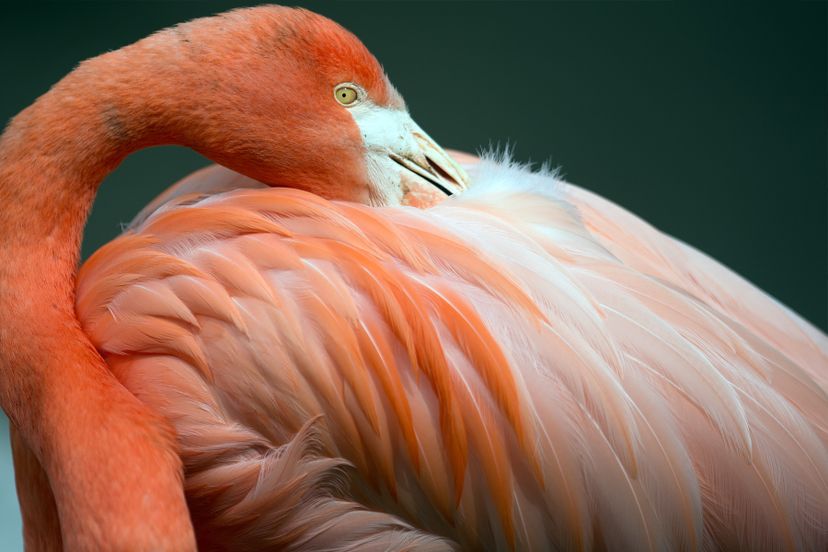
About This Quiz
The natural world is full of color, everywhere you look! Do you have the vision to ace this quiz on colors in nature?Zebras are born white with brown stripes. The zebra's stripes change to black about the time the zebra reaches its first birthday.
Soybean oil, which is a derivative of soybeans, is a primary ingredient in colored newspaper inks.
While rod and cone cells are both found in the retina, it is actually the cone cells that are sensitive to color.
Advertisement
Although we see many shades in between, the visible light spectrum is commonly divided into seven separate bands: red, orange, yellow, green, blue, indigo and violet.
Brown eyes are the most common eye color across the globe. More than 55 percent of the world's population have brown eyes.
In a turquoise gemstone, the mineral that creates this unique color is copper aluminum phosphate. The copper provides a blue color, while a green hue is provided by a small amount of iron. Together, these colors create turquoise.
Advertisement
All seven colors are present in sunlight. A prism can be used to separate each color individually.
Methane, which is present in the upper atmosphere of Neptune, reflects blue light from the sun back into space. This gives Neptune its blue appearance.
Red hair is the rarest of natural hair colors. Only about two percent of the world's population has naturally occurring red hair.
Advertisement
The colored part of the eye is called the iris. Pigmentation within the iris is what determines eye color.
Emu eggs are a deep emerald green. Emus lay their eggs in grassy areas, and the green color is designed to keep the eggs camouflaged.
Flamingos are actually born with grey feathers. Their feathers gradually turn pink when they eat a diet of brine shrimp and algae that contain a pink dye called canthaxanthin.
Advertisement
The hemoglobin molecule in human blood contains iron atoms. It is this iron that makes our blood red.
The mantis shrimp is believed to have the widest range of color vision in the animal kingdom. The mantis shrimp have 12 different types of photoreceptors, while humans have just three.
Manganese is the trace element that provides the violet color of amethyst. Manganese appears on the periodic table as Mn and is atomic number 25.
Advertisement
Tigers have striped skin that matches their striped fur. The skin with darker pigmentation grows dark-colored fur, while the skin with lighter pigmentation grows light-colored fur.
Polar bears have black skin covered by transparent and pigment-free fur. The fur appears white because it is so efficient at reflecting light.
Cone cells are one of two types of photoreceptor cells in the retina of the eye. Dogs have only one-tenth of the amount of cones cells in their eyes as humans. Because of this, they see only two colors: blue-violet and yellow.
Advertisement
Insect blood, or hemolymph, is clear with a yellow or green tint. The yellow or green pigment likely comes from plants the insects have eaten.
The wavelength of the color spectrum that is visible to people is 400 to 700 nanometers. Violet is on the low end, at 400 nanometers, and red is on the high end at 700 nanometers.
Specialized color-changing cells called chromatophores allow cephalopods to change colors. Each organism has thousands of chromatophores that can be activated at-will, often to hide from predators.
Advertisement
Blue light travels in shorter waves and is reflected, or scattered, by tiny molecules in the Earth's atmosphere to a greater degree than other colors. This gives the sky a blue hue on clear, cloudless days.
Chameleons have specialized skin cells, called iridophore cells, that contain nanocrystals of various sizes and shapes. By exciting or relaxing the skin, and therefore these nanocrystals, the chameleons can change skin colors.
The red color of rocks and soil on Mars is due to a high concentration of iron.
Advertisement
Clouds are white because of reflected light. The water droplets or ice crystals in clouds are large enough to reflect the wavelengths of all seven colors, which combine to make white light.
The color of chicken eggs is determined by the hen's genetics. Certain breeds will produce white eggs, while others will produce brown eggs. There's even a type of chicken that will lay blue and green eggs, although the breed is not officially recognized by the American Poultry Association.
Lobsters, snails and spiders all have blue blood because of an oxygen-carrying molecule called hemocyanin. The central atom of hemocyanin is copper, and when exposed to oxygen, this copper will turn blue.
Advertisement
Goldfish pigmentation is adversely affected by inadequate exposure to light.
Heterochromia is the term for an individual with different colored eyes. The condition can be caused by injury, disease process or genetics.
Chlorophyll is present in all green plants and cyanobacteria. The pigment absorbs light to provide energy for photosynthesis.
Advertisement